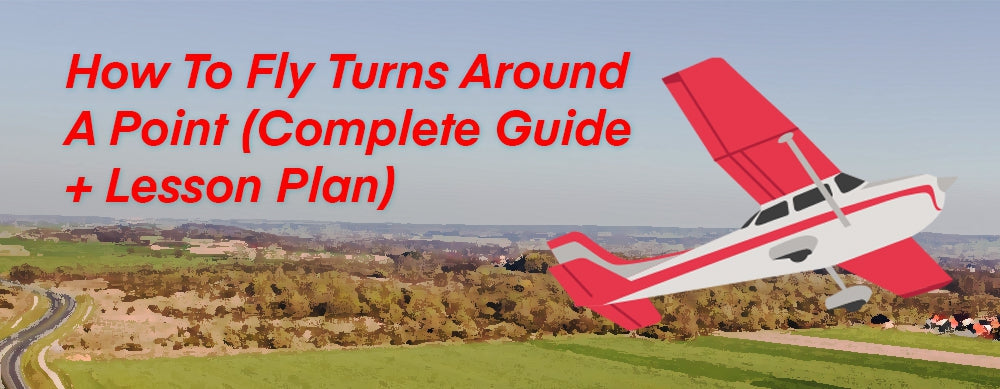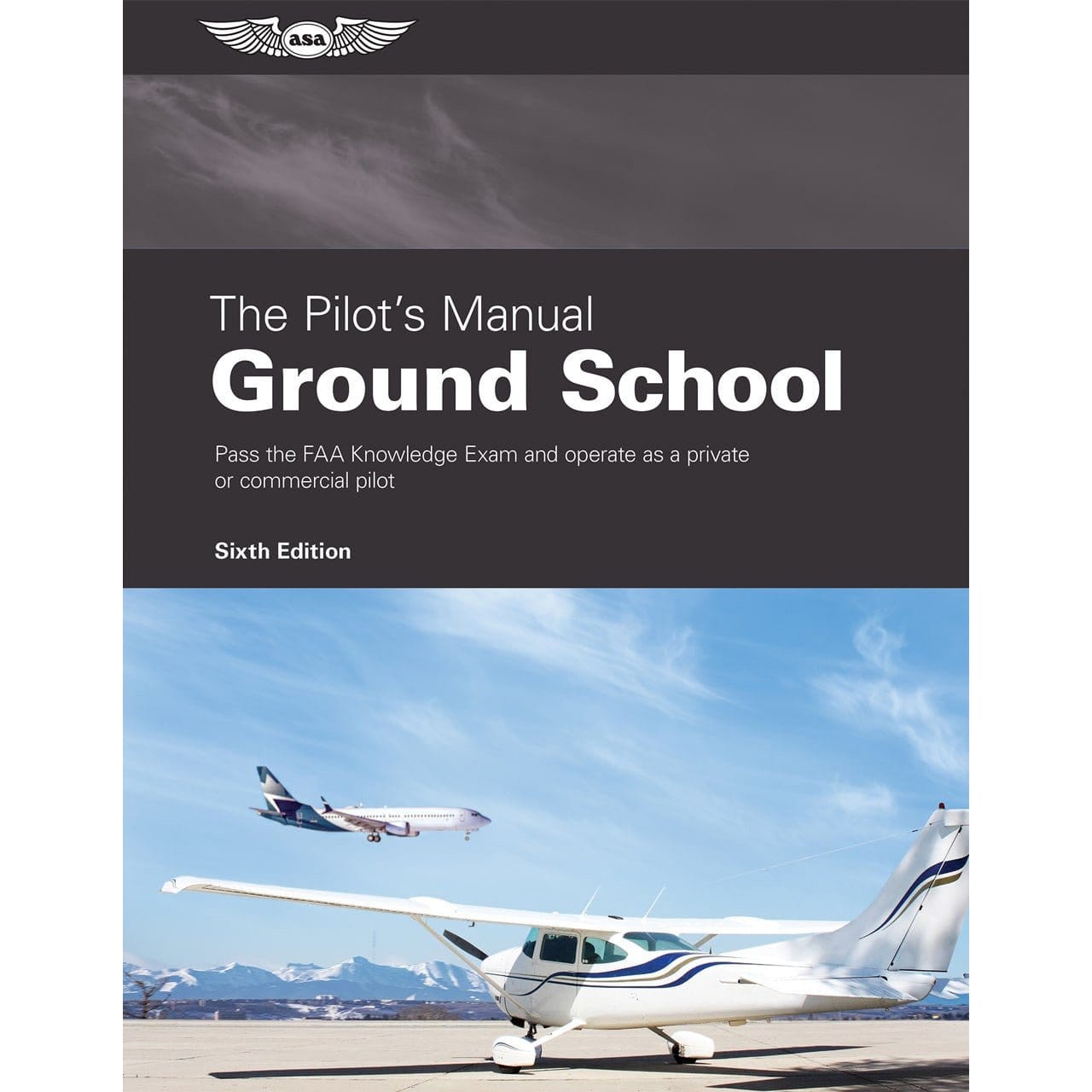Are you ready to take your flight training to the next level? Ground reference maneuvers are an important part of mastering the skies! With this in mind, let's explore "turns around a point". It's exactly what it sounds like: you'll be flying in circles for an hour at a time. While it may seem superfluous, there is actual value to this exercise.
In this guide, we'll walk through why learning turns around a point is important and provide step-by-step instructions on how to perfect it.
Let's get started!

What are Turns Around a Point?
Turns around a point are part of the ground reference maneuvers. It involves maintaining a constant radius turn around a reference point located on the ground.
Why Learn How to Turn Around a Point?
The aim of this maneuver is to help pilots improve their ability to scan and manage their cross-control checks along with flying the aircraft while accounting for wind direction.

How to Perform a Turn Around a Point
Print out the steps for your turns around a point lesson plan. Either you and your student(or your instructor) should take time to brief the steps needed in order to successfully perform this maneuver during your check-ride.
Keep in mind, a high wing airplane(such as a Cessna) can present specific challenges during this maneuver due to the lowered wing blocking the pilot's view of the point.
1. Perform Clearing Turns
Remember that this is a visual maneuver. The first step is to perform clearing turns and scan for traffic. Once the clearing turns are completed, be aware that you will need to keep scanning throughout the course of performing your turns.
2. Decide on a Ground Reference Point
Look around and identify a good ground reference point. These tend to be in unpopulated areas that are clear of houses, you'll want to avoid any safety hazards. Plan for an unintended possible emergency and select an area where you'd be able to land within gliding distance.
3. Figure out the Wind Direction
Determine wind direction using water, trees, smoke, fields; anything on the ground that can give you indications of wind directions. Failure to properly assess wind direction can cause the aircraft to not be positioned correctly for entering into the maneuver.
4. Enter on the Downwind
Make sure you maintain a level altitude prior to entering into the downwind half and follow the recommended airspeed for your aircraft.
You'll need to perform a steep bank turn initially due to the forceful tailwind and highest ground speed.
The speed of the ground will determine how deep the bank should be: Faster ground speed equals sharper turns, while slower groundspeed calls for gentler turns.
5. Maintain Altitude
Keep your altitude between 600 and 1000 feet AGL with an appropriate distance between your aircraft and the reference point.
The restrictions for the maneuver are ±100'. You will need to frequently check the altimeter to maintain altitude during the course of this maneuver.
6. Roll into The Turn Around a Point
On the initial bank, you will need to maintain the steepest angle and steepest bank, Once you have passed the reference point, execute a coordinated roll-in, maintaining a consistent radius and adjusting your bank angle up to 45° for the best result.
7. Angle of Bank and Wind Direction
Ease your banking angle as you round the corner, adjusting for wind-drift and your slowing speed. Be aware of the appropriate wind correction angle as well. With these things in mind, you can maintain a steady course.
8. 180-degree Point
Once you get close to the 180-degree point, your speed will start to decrease. This is the time when you need to be gentle with your control stick and keep your bank angle light. That way, you'll stay in a nice, constant radius turn around your point of reference.
9. Scanning
Stay vigilant during your maneuver scan, pay attention to your altitude, keep an eye out for other aircraft, and remember the direction of your bank.
10. Roll Out
Once you've completed a full turn around a point, feel free to fly straight and level. If your examiner has other requests, they will surely let you know!
Be sure to check out this great video by ERAU Special VFR on how to perform this maneuver.
Common Errors
Try and avoid making these common errors when practicing your turns around a point.
1. Failure to Clear
Prior to starting the maneuver, find a location that will not be disruptive towards any flight traffic or be close to airports where anyone is entering in and out of a traffic pattern. Listen to radio communications and visually scan for any aircraft during your clearing turns.
2. Lack of Wind Assessment
Ensure you are factoring in the appropriate wind correction angle, so it can take advantage of Mother Nature’s force. If you misjudge the wind conditions, then the plane won't be able to complete its maneuver properly.
3. Lacking Aircraft Stability
Make sure your aircraft is properly aligned and stabilized before entering the maneuver. If you don't maintain altitude and direction, or the trim isn't quite right, it can be hard to keep the bank angle or your altitude up.
4. Fixating on a Point
Occasionally checking on your ground reference point is fine, but avoid becoming fixated on it. Use it as a measure of how far you are drifting away and then return focus on properly flying the aircraft.
5. Failure to Maintain Altitude and Airspeed
You'll want to keep checking your altimeter and airspeed indicator to ensure you are properly maintaining both of these.
6. Uncoordinated Cross-Control
Scan your instruments and keep the aircraft moving in a smooth and continuous manner.

Takeaways
Turning around a point is a fundamental exercise for every pilot. Consider it an opportunity to embrace and perfect your skillset!
Here are a few tips to take on board:
-
Precision - Choose a reference point on the ground and strive for consistent radius, altitude, and heading.
-
Control - Take command of the aircraft, using the rudder, elevator, and aileron with finesse.
-
Wind Awareness - Properly assess wind direction and rely on your bank angle and throttle control to counteract wind drift.
-
Eyes Outside - Stay vigilant to other traffic in your vicinity.
-
Safety First - Remember to avoid safety hazards at all times when performing this exercise.
-
Practice Matters - Regular sessions with an experienced instructor can help you refine your technique.
-
Real-World Application - Turns around a point form the basis of successful instrument approaches, navigating traffic patterns, and more.
Books to Help with Turns Around a Point:

|
ASA Visualized Flight Maneuvers Handbook - High WingWhereas most books on flight maneuvers lump all airplane models into a single conglomeration that supposedly represents the entire GA fleet, ASA recognizes that numerous flight and maneuvering characteristics vary substantially between airplane styles and configurations. In its Visualized Flight Maneuvers Handbook - High Wing, ASA focuses on operating characteristics unique to high-wing planes. |

|
ASA Visualized Flight Maneuvers Handbook - Low WingRecognizing that high-wing and low-wing airplanes have vastly different sight pictures and handling characteristics on everything from steep turns to ground reference maneuvers to ground effect tendencies, ASA developed the Visualized Flight Maneuvers Handbook - Low Wing to concentrate on the qualities specific to the low-wing members of the GA fleet. |
Want to learn about flight maneuvers?
Our guides are designed to help student pilots become professional pilots and for private pilots to brush up on their knowledge and skills.
Did you find this article helpful?
Do you think we missed anything important? Let us know in the comments below!









